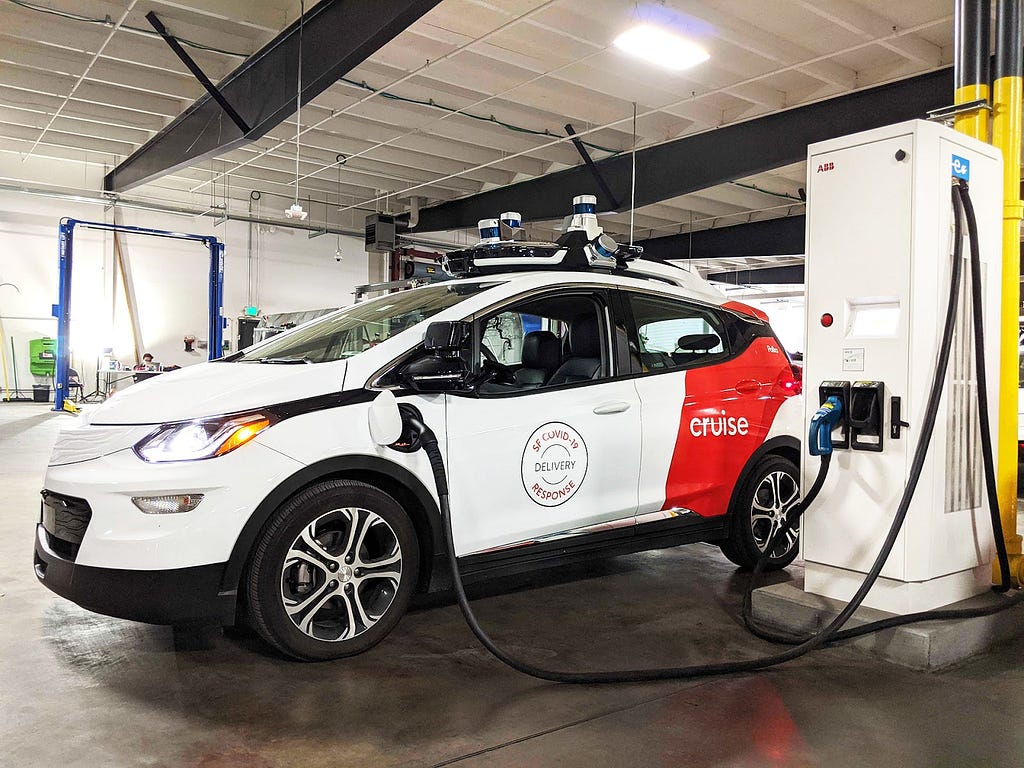
Today, with fewer cars on the road, we’re getting a real-world look at the impact of fewer tailpipe emissions. In the San Francisco Bay Area, carbon dioxide emissions have decreased by roughly 20% and nitrogen dioxide emissions by roughly 40%. It’s a stark reminder that small actions on a large scale can make a big impact.
At Cruise, we are committed to transforming transportation and making a positive impact on the environment with our zero-emissions fleet of self-driving vehicles. In California, transportation accounts for over 40% of total emissions, 70% of which come from light-duty passenger vehicles.
We’re proud to be the only self-driving company to not only operate an entire fleet of all-electric vehicles, but do so with 100% renewable energy. That’s why we’re excited to share our plans on how to further reduce the harmful impact of greenhouse gas (GHG) emissions by optimizing the battery life of our electric vehicles.
Battery life optimization reduces carbon emissions from battery manufacturing
Every Cruise electric vehicle (EV) is equipped with a high-voltage, lithium-ion battery that powers our vehicles and autonomous hardware. While our vehicles produce zero direct tailpipe emissions on the road, EV battery production does emit GHG emissions. It is estimated that lithium-ion battery manufacturing produces between 61–106 kg CO2-equivalent/kWh battery capacity. For a single EV battery, that’s the equivalent annual CO2 absorption of 200–300 trees.
One way Cruise will further reduce our long term emissions is by increasing our battery lifespans. This will ensure that fewer batteries need to be manufactured, and thus help us reduce overall battery waste. Here are three ways we intend to optimize our fleet’s electric vehicle batteries to expand their lifespan.
Demand-dependent charge level
One of the major factors that drives battery deterioration is the maximum charge level. In many ways, a battery can be viewed as an elastic band. Charging the battery is similar to stretching the elastic band, where potential energy is stored in the system. Charging the battery to the maximum charge level is like stretching the elastic band as far as it can go — significant energy is stored in the system, but the overall strain is higher as well. Repeatedly charging the battery to the highest level will more rapidly deteriorate the battery.
We will optimize battery life by matching the charge level to the service demand. In the future, we’ll efficiently take our passengers to their destinations without charging our batteries more than necessary.
Demand-dependent charge rate
Batteries can be charged at different rates using a direct current fast charger or a slow charging system. Continual fast charging causes additional strain to the lithium-ion battery, which can accelerate battery deterioration. Depending on the demand and the needs of the business, we will optimize our charge rate to increase overall battery life. If we want to charge our vehicles quickly, we’ll use a direct-current fast charger to fully charge our vehicle in about one hour. If we don’t need to charge so quickly, we’ll use a slower charging system that will fully charge the vehicle over multiple hours.
Reduced power draw
Our batteries power both the vehicle and our autonomous system which includes sensors, computers and other components. As a result, vehicle-level power draw for our autonomous systems plays an important role in overall battery life. Lower power consumption within our vehicles means we can travel more miles with the same amount of energy, which extends the life of our batteries and reduces the amount of electricity we consume. We keep improving our AV power consumption by ensuring our AV hardware system conducts real-time, safety-critical sensing and perception tasks in an energy efficient way.
We will also practice smart fleet management with intelligent routing. Since we manage our AVs as one fleet, we’ll work to reduce miles in which we’re not carrying any passengers and avoid high traffic areas or steep grades to ensure we’re limiting our overall power draw. Together, these practices will help our batteries last for many years.
Second-life applications and battery recycling reduce waste
As EV demand grows, it is anticipated that by 2030 the world will generate 2 million metric tons of used lithium-ion batteries, with less than 5% of these batteries being recycled. At Cruise, we strive to keep our EV batteries out of landfills once we can no longer utilize them in our fleet. We are exploring second-life applications for our batteries as stationary energy storage systems and are also investigating methods for best recycling our batteries when it is not possible to find a second-life use.
By finding second-life applications and recycling our spent batteries, we’ll continue to shrink our annual GHG emissions footprint and reduce our reliance on the scarce natural resources that go into battery production.
Expanding public access to sustainable transportation
Cruise is committed to delivering a self-driving service that is environmentally sustainable. We started by choosing to have an all-electric fleet and powering that fleet with 100% renewable energy. As we roll out our service in San Francisco, we’ll implement additional sustainable methods to reduce our carbon footprint, one of which is optimizing our battery’s life. By utilizing the battery optimization methods mentioned above, we expect to increase the lifetime of our EV batteries by 50% or more. This would decrease our annual contribution of battery production GHG emissions by 30%.
Efforts like these, alongside our work to expand our charging network across San Francisco, are all part of our efforts to expand the public’s access to sustainable transportation alternatives and speed the transition from single-occupant, gasoline-powered cars to Cruise’s shared, all-electric, self-driving service. This evolution in transportation will make our roads safer and our air cleaner while giving people more time and better access, one self-driving Cruise at a time.
To learn more about our vision for the future, visit our website.
Charging Into a Greener Future: Optimizing Battery Life in Cruise’s All-Electric, Autonomous Fleet was originally published in Cruise on Medium, where people are continuing the conversation by highlighting and responding to this story.